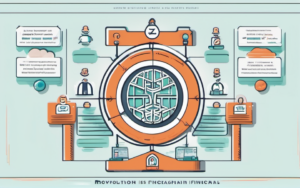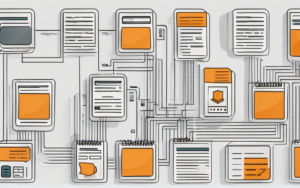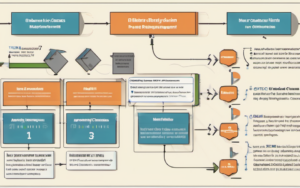Blockchain technology is revolutionizing numerous sectors, and its potential to empower the unbanked population is particularly compelling. Billions of people worldwide lack access to traditional financial services, hindering their economic participation and overall well-being. This is where the transformative power of blockchain comes into play.
1. Introduction
1.1 The Global Challenge of Financial Exclusion
Financial exclusion, the lack of access to formal financial services like bank accounts, credit, and insurance, disproportionately affects vulnerable populations in developing countries. This limits their ability to save, invest, and participate fully in the economy. Consequences include reliance on informal and often exploitative lending practices, limited access to education and healthcare, and increased vulnerability to economic shocks. The absence of a formal financial footprint makes it difficult to build credit history, access loans for small businesses, or participate in the digital economy.
Millions remain outside the formal financial system, trapped in a cycle of poverty and limited opportunities. This highlights the urgent need for innovative solutions to bridge this gap.
1.2 Blockchain’s Potential for Inclusion
Blockchain technology offers a unique opportunity to address this challenge. Its decentralized nature, enhanced security features, and ability to facilitate transparent and efficient transactions make it an ideal tool for financial inclusion. By creating a secure and accessible platform for financial transactions, blockchain can empower individuals to manage their finances, access credit, and participate in the global economy. This disruptive technology has the potential to reshape financial services, offering a lifeline to those previously excluded. The implications for economic growth and social development are profound.
2. Understanding Blockchain Technology
2.1 Decentralized Ledger Technology Explained
At its core, blockchain is a decentralized, distributed ledger technology. Think of it as a shared, immutable record of transactions replicated across multiple computers. This eliminates the need for a central authority, like a bank, to manage and verify transactions. Each transaction is grouped into a “block,” which is then added to the chain, creating a chronologically ordered and tamper-proof record. This inherent security is crucial for financial transactions.
The decentralized nature ensures that no single entity controls the system, mitigating risks associated with single points of failure and censorship.
2.2 Key Features: Transparency, Security, and Immutability
Transparency is a key advantage; all transactions are recorded on the public ledger, promoting accountability and trust. Security is enhanced through cryptography, making the blockchain highly resistant to tampering or fraud. Immutability ensures that once a transaction is recorded, it cannot be altered or deleted, providing an auditable trail of all financial activity. These features are particularly valuable in environments where trust in traditional institutions may be limited. This combination of characteristics makes blockchain a compelling solution for the unbanked.
3. Blockchain Applications for the Unbanked
3.1 Digital Identity and KYC/AML Compliance
3.1.1 Secure Identity Management Systems
Blockchain can create secure and verifiable digital identities for individuals lacking formal identification. This is crucial for accessing financial services. Blockchain-based identity systems can store and manage personal information securely, preventing identity theft and fraud. This is a significant step towards financial inclusion for millions who lack the necessary documentation.
3.1.2 Streamlined Onboarding Processes
The process of opening a bank account or accessing financial services can be cumbersome and require extensive paperwork. Blockchain can streamline this process, making it faster, cheaper, and more accessible for unbanked individuals.
3.2 Microfinance and Lending
3.2.1 Peer-to-Peer Lending Platforms
Blockchain facilitates peer-to-peer lending platforms, connecting borrowers and lenders directly without intermediaries. This can significantly reduce transaction costs and improve access to credit for small businesses and entrepreneurs in developing countries. This also empowers individuals who might otherwise be excluded from traditional lending systems.
3.2.2 Transparent Transaction Records
Blockchain ensures transparent and auditable records of loans, improving accountability and reducing the risk of fraud. This fosters trust between borrowers and lenders, creating a more sustainable microfinance ecosystem.
3.3 Remittances and Cross-Border Payments
3.3.1 Reduced Transaction Costs
Traditional remittance systems often involve high fees and slow processing times. Blockchain can significantly reduce these costs and speed up transfer speeds, benefiting migrant workers sending money back home. This is particularly impactful for those in developing countries who rely on remittances for their livelihood.
3.3.2 Faster Transfer Speeds
Blockchain enables near-instantaneous cross-border payments, reducing delays and uncertainty. This is crucial for individuals relying on timely funds for essential needs.
3.4 Supply Chain Finance and Agriculture
3.4.1 Tracking Goods and Ensuring Fair Pricing
Blockchain can track goods throughout the supply chain, ensuring transparency and preventing exploitation of farmers and producers. This allows for fair pricing and improved traceability, benefiting both producers and consumers.
3.4.2 Empowering Smallholder Farmers
By providing a transparent and secure platform for transactions, blockchain empowers smallholder farmers to access markets, receive fair prices for their products, and improve their livelihoods. This is crucial for sustainable agricultural development in many regions.
4. Challenges and Considerations
4.1 Infrastructure and Digital Literacy
Lack of reliable internet access and digital literacy remains a significant barrier to blockchain adoption. Addressing this requires investment in infrastructure and digital literacy programs. This is crucial for ensuring widespread access to blockchain-based financial services. Investment in education is key.
4.2 Regulatory Frameworks and Governance
Clear regulatory frameworks are essential to ensure the responsible development and implementation of blockchain technology in the financial sector. Governments need to establish guidelines for KYC/AML compliance and data protection to build trust and prevent misuse. Proper regulatory frameworks are crucial for preventing financial crimes and ensuring the ethical operation of these services.
4.3 Scalability and Interoperability
Blockchain technology needs to scale to handle a large number of transactions efficiently. Interoperability between different blockchain platforms is also essential to facilitate seamless transactions and data exchange. Ongoing development and improvement of blockchain technologies are vital to solve these issues.
5. Case Studies and Examples
5.1 Successful Blockchain Projects for Financial Inclusion
Several successful blockchain projects are already demonstrating the potential of this technology to empower the unbanked. These projects highlight the practical applications and the positive impact on communities. Examples include initiatives focused on microfinance, remittance services, and supply chain management in different parts of the world. Learning from these success stories is vital for the wider implementation of this technology.
5.2 Lessons Learned and Best Practices
Analyzing successful projects helps identify best practices and avoid potential pitfalls. Sharing lessons learned is crucial for the successful scaling of blockchain technology for financial inclusion. Identifying best practices is essential for the effective deployment of this technology.
6. The Future of Blockchain and Financial Inclusion
6.1 Potential for Further Innovation
Ongoing research and development continue to unlock new possibilities for blockchain technology to improve financial inclusion. Innovations such as decentralized finance (DeFi) and stablecoins hold immense potential to further expand access to financial services. This represents a major step towards greater financial inclusion globally.
6.2 Collaboration and Partnerships
Successful implementation requires collaboration between governments, NGOs, financial institutions, and technology providers. Partnerships are crucial for addressing infrastructural challenges, promoting digital literacy, and establishing supportive regulatory frameworks. This collaborative approach is key to successfully incorporating blockchain technology in financial inclusion strategies.
The transformative potential of blockchain technology to empower the unbanked is undeniable. By addressing the challenges and fostering collaboration, we can unlock its full potential to create a more inclusive and equitable financial system, fostering economic growth and social progress worldwide. The future of finance is inclusive, and blockchain technology is at the forefront of this revolution.




